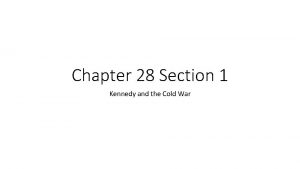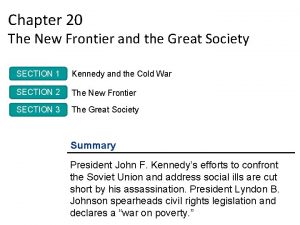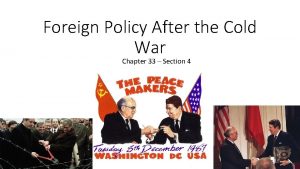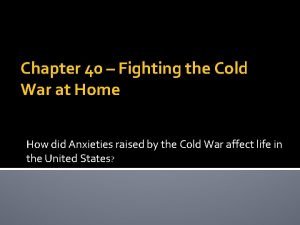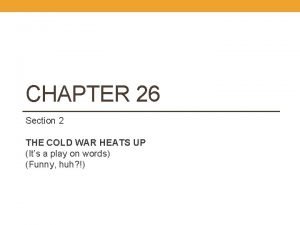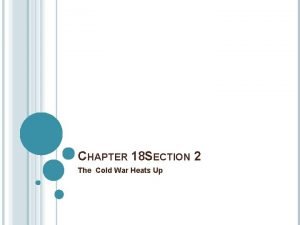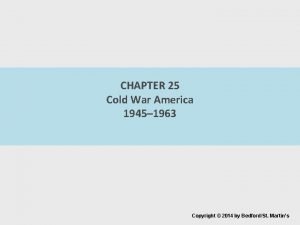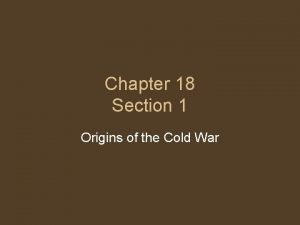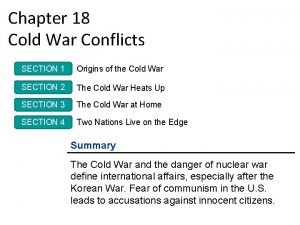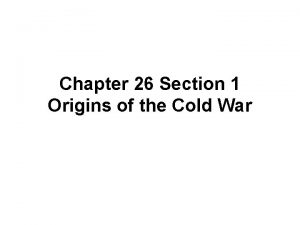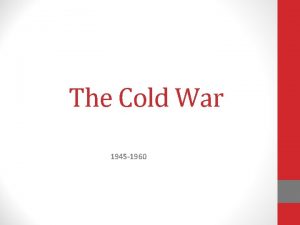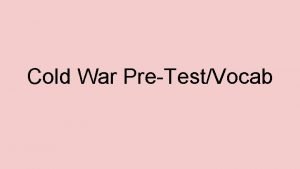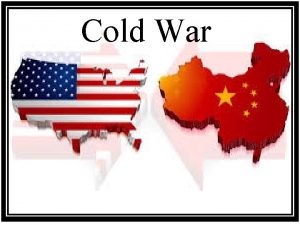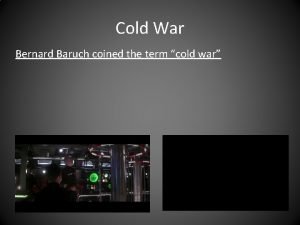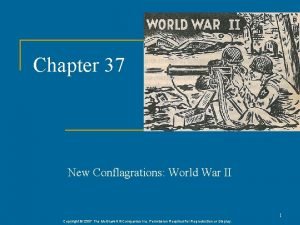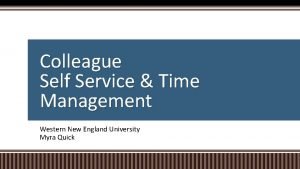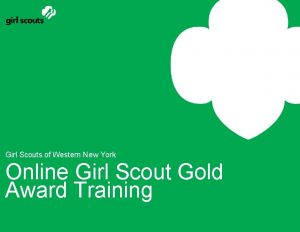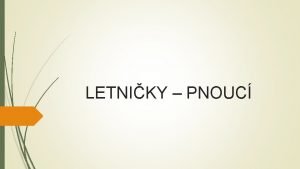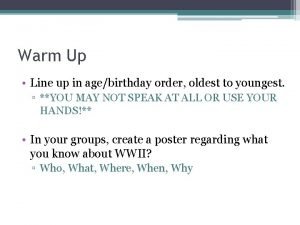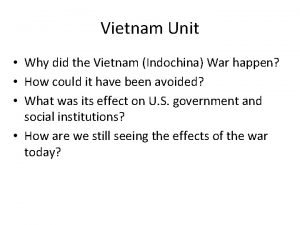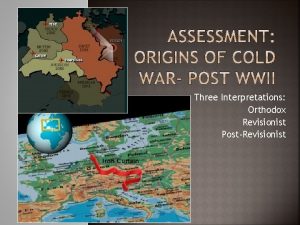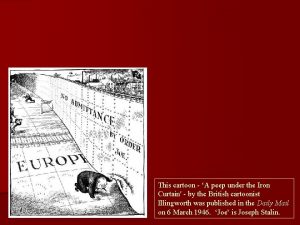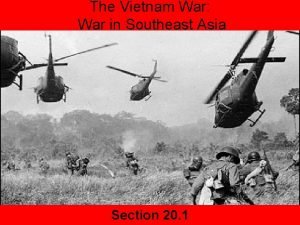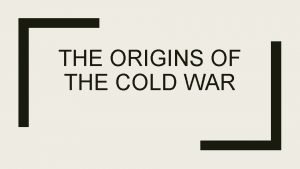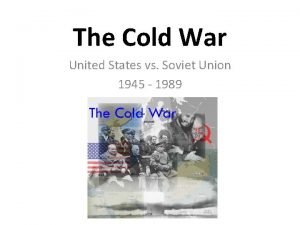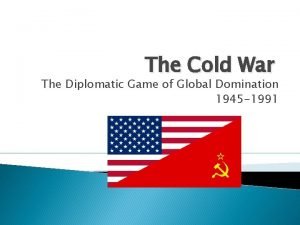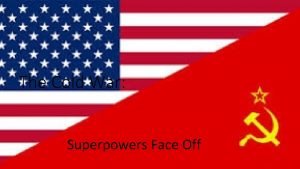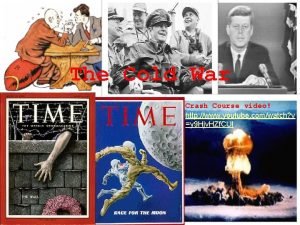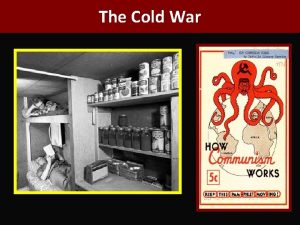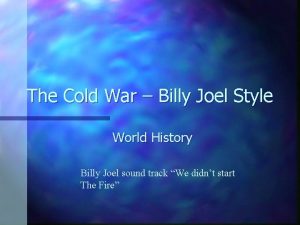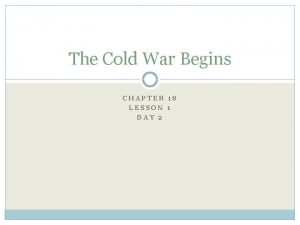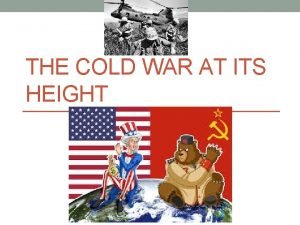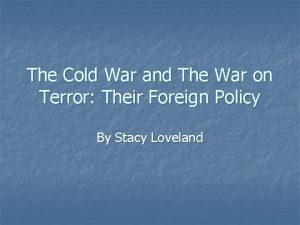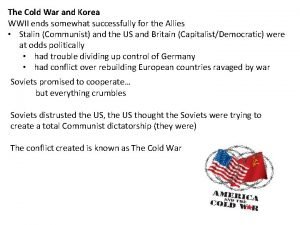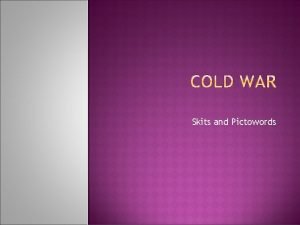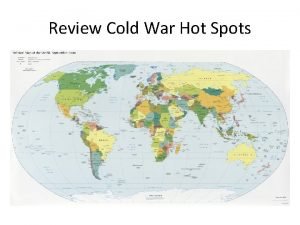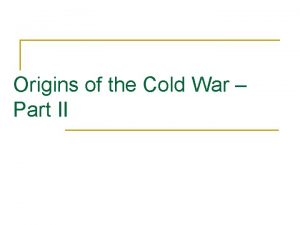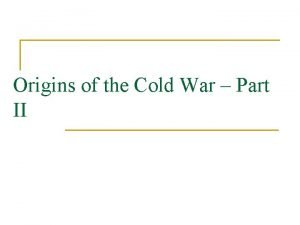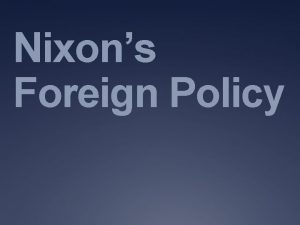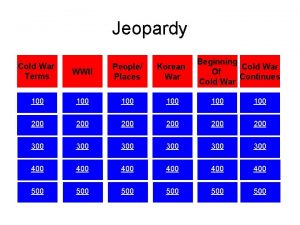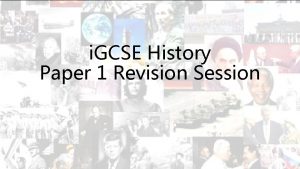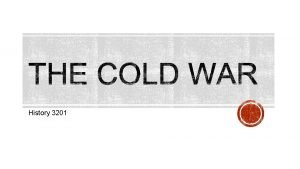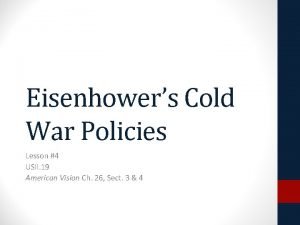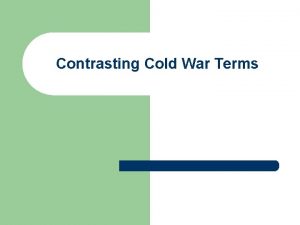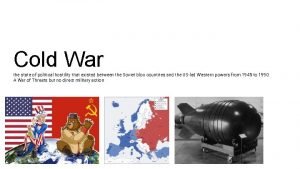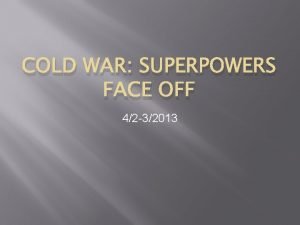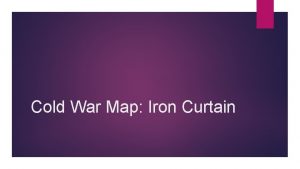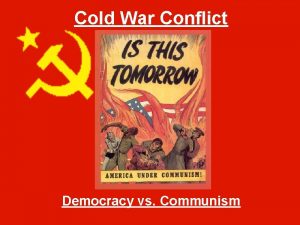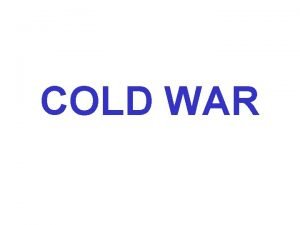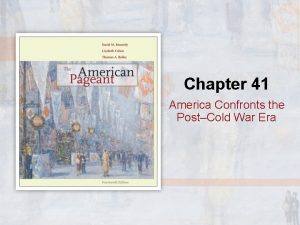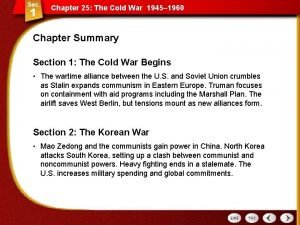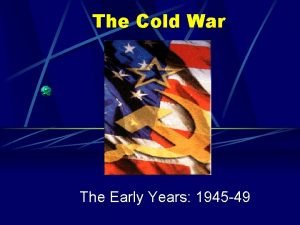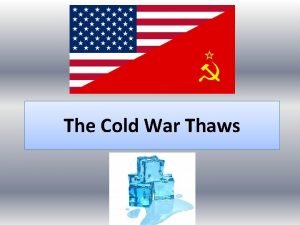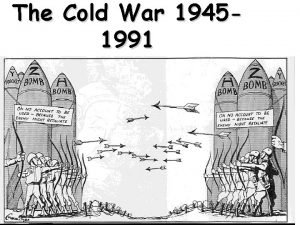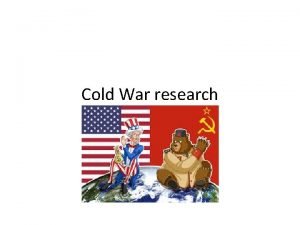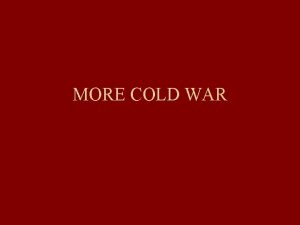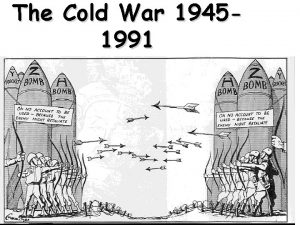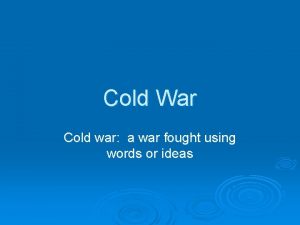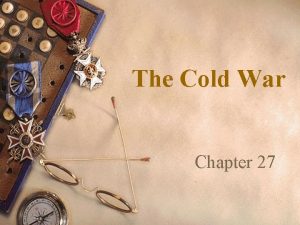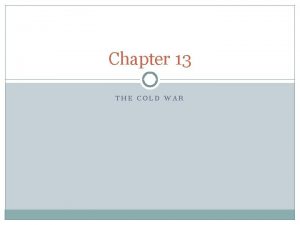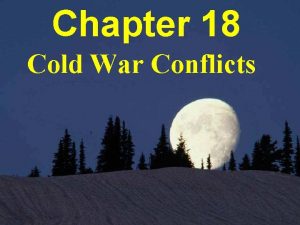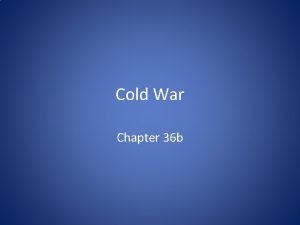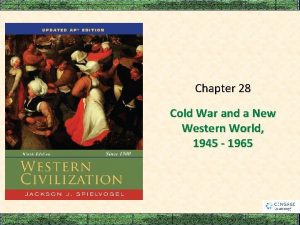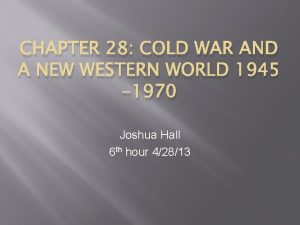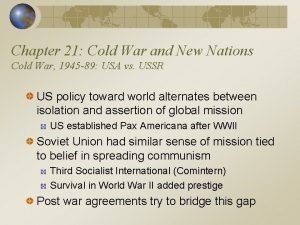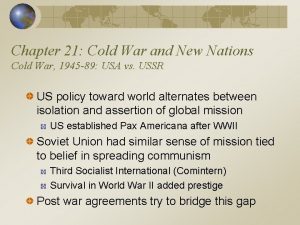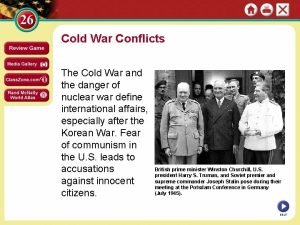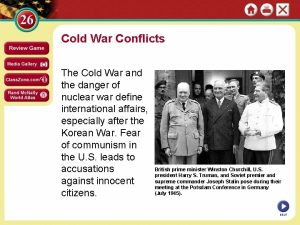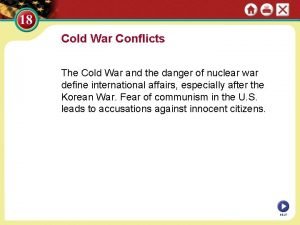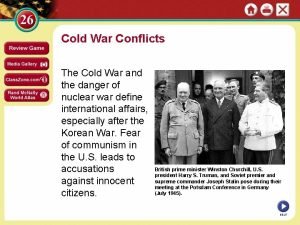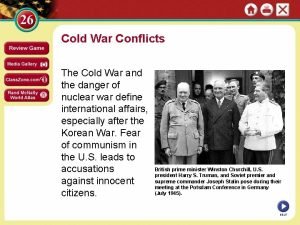Chapter 28 Cold War and a New Western





























































- Slides: 61

Chapter 28 Cold War and a New Western World, 1945 - 1970

Confrontation of the Superpowers WWII devastated the countries, cities and people of Europe, bringing about an end to European supremacy in the world. The Cold War The indirect conflict between the Soviet Union and the U. S. over ideologies and control of the post WWII world. First Area of Conflict - Disagreement over Eastern Europe United States and Britain championed self-determination and democracy Soviet forces occupied all of Eastern Europe and wanted to establish pro-Soviet governments there to create a buffer zone against potential western attacks. Between 1945 and 1947 Communist governments were entrenched in East Germany, Bulgaria, Romania, Poland, and Hungary

Possible Test Question World War II not only devastated the countries, cities, peoples, and cultures of Europe, but also destroyed American commitment to globalism in foreign policy. European supremacy in world affairs. Any commitment of old and new nations around the globe to supranational bodies of diplomacy and conflict resolution. The capacity of western European nations to forge lasting economic and cultural ties in the post-war world. The trans-Atlantic partnership.

Truman Doctrine, March 12, 1947 U. S. foreign policy developed due to a civil war in Greece Provided $400 million in aid to countries threatened by aggression. Assistance in defense of Greece and Turkey Defined America’s fear of Communist expansion Pledged U. S. support to support “free peoples” and “Fight Communism anywhere, anytime” Marshall Plan, June 1947, European Recovery Program $13 billion for the economic recovery intended to rebuild war-torn Europe Soviet view – Western European countries sold their political & economic freedom for U. S. loans. Made Stalin push for more control of Eastern bloc countries The American Policy of Containment Stop the spread of Communism

Possible Test Question The Marshall Plan Was viewed by Western Europe as Capitalist imperialism. Included Soviet Union and Eastern Europe. Was not considered a success. Came to an abrupt end with the imposition of the Berlin Blockade by the Soviet Union. Intended to rebuild European prosperity and stability.

Contention over Germany is partitioned into 4 sections (so is Berlin) Soviets dismantle and remove 380 factories Blockade of Berlin, 1948 -1949 • Soviets cut off rail and road access through East Germany • Supplies were flown in to west Berlin • Soviets eventually back down Germany separated, 1949 • West German Federal Republic, September • German Democratic Republic, October - East Germany Cold War Tension Soviet Union detonates its first atomic bomb, 1949 Communist forces win the Civil War in China, 1949 Mutual deterrence – belief that an arsenal of nuclear weapons prevented war through mutually assured destruction

New Military Alliances North Atlantic Treaty Organization, (NATO) 1949 • Western Alliance • Belgium, Britain, Denmark, France, Iceland, Italy, Luxembourg, the Netherlands, Norway, Portugal, Canada and the U. S. • A few years later, West Germany, Greece & Turkey joined Warsaw Pact, 1955 • Communist Alliance • Albania, Bulgaria, Czechoslovakia, East Germany, Hungary, Poland, Romania, and the Soviet Union

Possible Test Question The Warsaw Pact included all of the following nations except Poland. Bulgaria. Yugoslavia. Hungary. Czechoslovakia.

Globalization of the Cold War The Korean War Korea is divided after WWII • North is communist – supported by Soviet Union • South is democratic – supported by U. S. North Koreans invaded the south, 1950 UN troops push North Korean troops back into North Korea Chinese intervene when UN troops approach the border Uneasy truce, 1953 The overall effect of the Korean War was to reinforce the American policy of Containment Escalation of the Cold War in the mid-1950 s Policy of massive retaliation (Eisenhower) Central Treaty Organization Southeast Asia Treaty Organization

Possible Test Question The Cold War policy adopted in the mid 1950 s by the Eisenhower administration was Containment. Détente. MAD (mutually assured destruction) Massive retaliation. All of the above.

Another Berlin Crisis Vulnerability of Berlin • Western countries had to go through East Germany to get to West Berlin • Communists were losing intellectuals and skilled workers who were fleeing East Germany through West Berlin ICBM missile and Sputnik I launched Summit meeting in Vienna • Khrushchev threatens JFK with a 6 month deadline to abandon West Berlin Wall, built in 1961

Map 28. 1: The New European Alliance Systems in the 1950 s and 1960 s

The Cuban Missile Crisis Fidel Castro (b. 1927) Established a communist regime in Cuba - 1959 Failed Bay of Pigs invasion, 1961 Attempted overthrow of Castro regime by C. I. A. trained revolutionaries and given the go ahead by Pres. JFK US discovers Soviet missile bases being built in Cuba JFK orders a blockade of Cuba to prevent Soviet navy carrying missiles to Cuba from reaching their destination Khrushchev agrees to turn back ships carrying missiles in return for Kennedy’s promise not to invade Cuba Establish a hotline between US and Soviet Union improve communications to prevent a nuclear war Ban nuclear tests in the atmosphere

Possible Test Question The Cuban Missile Crisis of 1962 concluded with Improved communications between the United States and the Soviet Union essential to prevent nuclear war. The installation of Soviet missiles in Cuba. The United States overthrowing Cuba’s Sovietsupported government. John Kennedy backing down to the threats of Nikita Khrushchev. Fidel Castro giving up his military authority in the Cuban government, although he retained political control.

The Vietnam War Vietnam divided into North (Communist supported by Soviets) and South (Democratic supported by US) after France had been defeated in 1954 (decolonization) President Lyndon Johnson sends larger numbers of troops to Vietnam, 1965 US was fighting against the NVA (North Vietnamese Army) and the Vietcong (guerrilla fighters in the south who supported the north Domino Theory If the communists succeed in Vietnam, other nations in Asia would fall to communism Americans and Europeans began to protest American involvement in Vietnam

President Richard Nixon (1913 -1994) vows to bring an honorable end – vietnamization (replace US troops with S. Vietnamese troops) Begins withdrawing troops Peace treaty signed January 1973 calls for removal of all US troops The Vietnam War showed the limitations of American power Led to a period of relaxed Soviet-American relations in the 1970 s known as Détente

Possible Test Question The Vietnam War Was resolved in 1975 with the Helsinki Agreements. Ended in 1973 with the defeat of North Korea. Showed the limitations of American power, leading to improved Soviet-American relations. Marked the beginning of the total domination of Southeast Asia by the Soviet Union. Led to an immediate end of the Cold War in 1975 with the final withdrawal of Americans from Vietnam.

Decolonization Africa: The Struggle for Independence G. B. and France lacked the resources to control a colonial empire Colonies were aware of allied stance on self determination Western educated intellectuals began to lead independence movements Most African nations received their independence in the 1950 s & 1960 s. South Africa set up a system of segregated white rule known as apartheid.

Possible Test Question African independence parties were usually led by Western-educated intellectuals. Unemployed urban workers. Moscow-trained urban workers. Disgruntled peasants, fearful of being besieged by western agricultural surpluses. Religious leaders, both Christian and Muslim.

Map 28. 2: Decolonization in Africa

Conflict in the Middle East Emergence of new independent states The Question of Palestine Zionists wanted Palestine for a homeland After World War II sympathy grew for the Jews President Truman approves the idea of an independent Jewish state within Palestine Israel proclaimed a state, May 14, 1948 The one issue the Arab states were unified in was their opposition to the formation of Israel Nasser and Pan-Arabism (Arab unity) Colonel Gamal Abdel Nasser (1918 – 1970) seized control of Egyptian government in 1954 Advocated sharing Middle Eastern Oil wealth amongst Arab states Suez conflict (Britain, France & Israel attack Egypt) US & Soviet Union intervened on the side of Egypt to bring peace Nasser emerged as an Arab leader

Possible Test Question The Middle Eastern political leader who promoted Pan-Arabism and who advocated a sharing of Middle Eastern oil wealth equally among the Arab states was Yasir Arafat. Saddam Hussein. Anwar al-Sadat. The Shah of Iran. Gamal Abdul Nasser.

The Arab-Israeli Dispute Palestine Liberation Organization formed in 1964 Yasir Arafat (1929 – 2004) (PLO leader) June 5, 1967, the Six Day War begins • Preemptive strike against Arab nations • Israel destroyed Egyptian forces • Tripled the size of their country in 6 days Yom Kippur, 1973: Egypt attacks Israel • Air and artillery strike during Jewish holy day on Israeli forces in the Sinai peninsula • Conflict ends in a cease fire negotiated by the UN in 1974

Map 28. 3: Decolonization in the Middle East

Asia: Nationalism and Communism Philippines granted independence, 1946 India Muslims and Hindus Divided between Hindu India and Muslim Pakistan • • Gandhi was the only Congress leader to object He warned of an “orgy of blood” He was right Fighting between Hindus and Muslims killed over 1 million Assassination of Mahatma Gandhi, January 30, 1948 British grant independence to Ceylon (Sri Lanka) and Burma (Myanmar) French efforts to keep Vietnam by holding elections fail. Vietnam is divided

Possible Test Question “An orgy of blood” refers to The Vietnam War. The separation of Pakistan from India. The victory of Mao Zedong over the Chinese Nationalists. Nikita Khrushchev’s condemnation of Stalin. The Korea debacle.

China Under Communism After WWII, civil war continues in China Chiang Kai-shek (1887 -1975) (Nationalists) Mao Zedong (1893 -1976) (Communists) Chiang Kai-shek goes to the Island of Taiwan (US navy protects him) Collectivization of all farmland most industry and commerce nationalized, 1955 Great Leap Forward, 1958 • Mao’s effort to achieve a classless society • Collectivized farms were combined into “people’s communes” consisting of 30, 000 peasants • The program was a disaster due to weather and poor planning Great Proletarian Cultural Revolution, 1966 -1976 • Red Guards took to the streets to cleanse society of impurities associated with capitalism

Map 28. 4: Decolonization in Asia

Possible Test Question The Great Leap Forward was Stalin’s stated philosophy for his last five-year plan. The radicalization of the feminist movement. Mao Zedong’s effort to achieve a classless society and the final state of communism. The missile race between the United States and the Soviet Union. Mao Zedong’s New Economic Policy, modeled on Lenin’s economic reforms in the early 1920 s.

Decolonization and Cold War Rivalries Newly independent nations caught in U. S. – Soviet conflict Jawaharlal Nehru and Nonalignment Kept India neutral Tried to provide leadership to newly independent countries in Asia and Africa Indonesia Sukarno and Suharto • Sukarno received support from China and the Soviet Union • Overthrown by General Suharto who established pro-western relations

Possible Test Question The Indian politician who pursued a policy of neutrality in the Cold War and who attempted to provide leadership to the newly independent countries of Asia and Africa was Mahatma Gandhi. Indira Gandhi. Suharto. Sukarno. Jawaharlal Nehru.

The Soviet Union: From Stalin to Khrushchev Stalin’s Policies Stalin’s method for the recovery of the Soviet Union • Use Soviet labor to produce goods to export so Russia could bring in foreign capital to build machinery and Western technology By 1947 the Soviet Union had attained pre-war levels of industrial production • Emphasized development of heavy industry & the production of modern weapons and space technology (Sputnik) • Very few consumer goods produced Stalin continued his iron rule until his death in 1953

Possible Test Question The economic policies of Stalin Completely overtaxed a war-damaged industrial plant as production of material goods long failed to surpass prewar levels. Were unrealistic since Russia lacked readily accessible natural resources and fossil fuels. Managed to produce both “guns and butter, ” that is rearmed the Soviet military while providing cheap and plentiful consumer goods. Instituted a modified free-market capitalism in all economic areas except for heavy industry. Emphasized the development of heavy industry and the production of modern weapons and space vehicles.

Nikita Khrushchev (1894 -1971) Ends the forced labor camps Condemns Stalinist programs of forced labor and terror There seem to be a loosening of restraint (destalinization) Allowed more intellectual freedom • Allowed publication of Alexander Solzhenitsyn’s novel A Day in the Life of Ivan Denisovich which portrayed life in Stalin’s forced labor camps Encouraged rebellion in satellite nations • Rebellions will be crushed by Red Army (Hungary, Czech etc) Economic policies focused on production of light industry and consumer goods & increase agricultural output • Failed to benefit the Soviet economy and industry Forced into retirement by party members in 1964

Possible Test Question The economic policies of Nikita Khruschev in the 1950 s and early 1960 s Were a continuation of Stalinist policies. Were a great success. Failed to benefit the Soviet economy and industry. Focused on building the economy on luxury goods. Made the Soviet Union completely and permanently self-sufficient in agricultural foodstuffs.

Eastern Europe: Behind the Iron Curtain In 1945 Soviet Union occupied all of the Balkans Communist governments were under the control of the Soviet Union Due to strong democratic traditions, Czechoslovakia was the last Eastern European nation to fall under Soviet control Albania and Yugoslavia were the exceptions to total Soviet rule Albania had a Stalinist type regime, but became more independent Josip Broz, Tito, took control of Yugoslavia • Asserted Yugoslavia’s independence from the end of WWII into the 1970 s. • Form of communism was less centralized and closer to Marxist. Leninist ideal

Possible Test Question Due to its strong democratic traditions, the last Eastern European country to fall under Soviet, one-party domination after WWII was Bulgaria. Poland. Hungary. Czechoslovakia. Romania.

Eastern European countries followed the Soviet pattern Five year plans Farm collectivization Upheaval in Eastern Europe Khrushchev interferes less with the satellite countries Rebellion in Poland • • Wladyslaw Gomulka , 1956, elected first secretary Poland pledged to follow its own socialist plan Got nervous about a Soviet military response Compromised and agreed to support the Warsaw Pact

Eastern Europe: Behind the Iron Curtain: Hungary & Czechoslovakia Hungary, 1956 This time dissent was directed at communism as well Dissatisfaction and economic problems creates tense situation Imry Nagy (1896 -1958) declares Hungary free, November 1, 1956 Promises free elections – Soviet military invades Soviet military intervention reasserts Communist leadership Janos Kadar (1912 -1989) replaced Nagy Czechoslovakia, 1968 Antonin Novotny (1904 -1975) known as “Little Stalin” • Appointed by Stalin in 1952 • Resigned in the late 1960 s over protests Alexander Dubcek (1921 -1992), “socialism with a human face” • Initiated by Dubcek’s reforms – “Prague Spring” Reform crushed by the Warsaw Pact – Red Army invades Czech

Possible Test Questions The “Prague Spring” in Czechoslovakia in 1968 Was triggered by the reforms of Alexander Dubcek. Led to the presidency of Vaclav Havel in 1970. Witnessed Czechoslovakia’s successful withdrawal from the Soviet bloc. Brought about the resignation of President Gustav Husak. Was encouraged by the Soviet leadership.

Western Europe: The Revival of Democracy and the Economy Europe recovered rapidly from World War II Marshall Plan money was important to the recovery France: The Domination of De Gaulle Charles de Gaulle (1890 -1970) • Feels he has mission to reestablish the greatness of France • Kept France largely independent politically • Wanted to make France a nuclear power Defeat in Indochina Algerian crisis • Algeria rebels against France for independence • Anti-war movement almost leads to French civil war Fifth Republic, 1958 • Powers of the President enhanced Economic growth Student riots, Labor Strikes, in 1968 over rising cost of living Resignation of de Gaulle, April 1969

Possible Test Question As president of France, Charles de Gaulle’s position in the Cold War was to Closely align France with the Warsaw Pact nations. Make France the “third” nuclear power and pursue a largely independent political course. Let American policy guide France and other European nations. Make France the leading European power in NATO. Join the non-aligned third-world nations.

Western Europe: The Revival of Democracy and the Economy West Germany: A Reconceived Nation Konrad Adenauer (1876 -1967) (Christian Democrats) • Founding hero of West Germany Reconciliation with France Resurrection of the economy (“economic miracle”) • New currency, free markets, low taxes Payments to Holocaust survivors and Israel Great Britain: The Welfare State Clement Atlee (1883 -1967) (Labour Party) • British Welfare State (social security, socialized medicine) s National Insurance Act and National Health Act • Meant dismantling of the British Empire • No longer viewed as a world power after loss of Suez Canal Continued economic problems • Economy lagged behind and failed to re-industrialize • Lost colonies and their revenues • Debt from international commitments

Possible Test Question The first chancellor and “founding hero” of the West German Federal Republic was Helmut Kohl. Helmut Schmidt. Willy Brandt. Konrad Adenauer. Walter Ulbricht.

Italy: Weak Coalition Government Postwar reconstruction Alcide de Gaspari (prime minister, 1948 – 1953) Unstable political coalitions • Christian Democrats gained power with the backing of the Catholic Church Italy’s “economic miracle” • Marshall Plan helped stabilize the economy and increase production of steel and consumer goods

Western Europe: The Move Toward Unity European Coal and Steel Community (ECSC) France, West Germany, Belgium, Netherlands, and Luxembourg European Economic Community (Common Market) Founded for economic reasons Created a free-trade area Precursor to European Union

American Politics and Society in the 1950 s Influence of the New Deal influence continued by Truman, Kennedy, and Johnson Economic prosperity of the 1950’s Mc. Carthyism and the “Red Scare” Communist witch hunt in 50 s America

Decade of Upheaval: America in the 1960’s Johnson and the Great Society War on Poverty Job Corps Department of Housing and Urban Development Civil Rights Movement Civil Rights Act, 1964 – end segregation Voting Rights Act, 1965 – ending voting discrimination Martin Luther King, Jr. (1929 -1968) • Followed ideal of civil disobedience preached by Gandhi • Assassinated, 1968 – riots followed Malcolm X – black leader in northern cities • Did not share MLK’s view of civil disobedience Summer of 1965 – riots in major U. S. cities Antiwar Protests Kent State University, 1970 (students shot by national guard) Counter-culture alternative to middle class conformity Increased sexual permissiveness

Possible Test Question The upheavals in the United States in the 1960 s included all of the following except Demands for civil rights for African-Americans. A desire to adopt Soviet-style socialism as an alternative to rapacious capitalism. Protests against the Vietnam War Increased sexual permissiveness. Counter-culture alternatives to middle class societal norms.

The Emergence of a New Society The Structure of European Society Dramatic shift in the middle class with the addition of white-collar management and administrative positions Further urbanization Rising income • Lower class could afford the consumer goods enjoyed by the middle and upper classes Mass tourism • Increase in disposable income and vacation time plus a decrease in hours worked

Creation of the Welfare State History of Social Welfare Policies Extension of old benefits and creation of new ones Removal of class barriers Increased opportunity for higher education Increase in state spending on social services Gender Issues Work, motherhood, and individual rights • In West Germany and Britain, women were encouraged to stay home • France provided equal rights to women, but offered incentives to stay home and bear children

Women in the Postwar Western World Participation in the workforce declines until end of 1950 s Women gave up their jobs to returning soldiers “Baby Boom” Birth control – the pill Increased employment in the 1960 s Smaller families allowed women to work Feminist Movement: The Quest for Liberation Right to vote Simone de Beauvoir (1908 -1986) • The Second Sex, 1949 • Argued that women were seen as second class to men Betty Friedan (b. 1921) • The Feminine Mystique • Founder of the National Organization for Women (NOW)

Possible Test Question Betty Friedan Was the author of The Second Sex. Supported voting rights for women. Was a founder of the National Organization of Women. Headed Lyndon Johnson’s “war on poverty. ” Was an anti-feminist.

Social Revolutions The Permissive Society Sexual freedom Experimentation with drugs Decriminalization of homosexuality Increasing rates of divorce Education and Student Revolt Higher education becoming more widespread Problems • • Overcrowding Professors who paid too little attention to students Authoritative administrators Seemingly irrelevant education Student strikes in France were the most violent, 1968 • Students encouraged workers to back their protests Protest Western society and the war in Vietnam

Possible Test Question The most violent student revolts took place in France, where students successfully encouraged unionized workers to back their protests. Britain, where conservative governments attempted to use military force against demonstrators. Germany, where young Nazi sympathizers attempted to reestablish the Third Reich. Italy, where anti-church demonstrations led to the burning of Cathedrals. The United States, where student demonstrations brought an end to the Vietnam War.

Postwar Art and Literature Art New York replaced Paris as the center of the art world Jean Dubuffet • Borrowed distressed look of children’s art Abstract Impressionism • Jackson Pollock (1912 – 1956) • Known as action painting – painted on a canvas laid on the ground Pop Art • Andy Warhol (1930 – 1987) • Used images from popular culture Literature Theater of the Absurd • Samuel Beckett, Waiting for Godot • Günter Grass, The Tin Drum

Jean Dubuffet, Portrait of Jean Paulhan Jackson Pollack – Abstract Expressionism

Andy Warhol – Pop Art

Possible Test Question The American artist Jackson Pollock was most noted for A return to extreme realism in his paintings. Postmodernist sculptures. Pop Art, which celebrated the whims of popular culture. Neo-Cubism. Abstract Expressionist paintings.

The Philosophical Dilemma: Existentialism Central point was the absence of God in the universe Humans had no preordained destiny Stressed the need for people to create their own values and give their own lives meaning The Revival of Religion Karl Barth (1886 – 1968) – Protestant • Because people are sinners and imperfect, humans can only know religious truths through the grace of God. Karl Rahner (1904 – 1984) – Catholic • Incorporated modern thought into the Catholic Church Vatican II • Pope XXIII liberalized some Catholic practices

The Explosion of Popular Culture as a Consumer Commodity Link between mass culture and mass consumer society The Americanization of the World US influence on world culture Movies • primary method to spread US culture Television Popular music
 The cold war lesson 1 the cold war begins
The cold war lesson 1 the cold war begins Cold war proxy wars
Cold war proxy wars Chapter 28 section 1 kennedy and the cold war
Chapter 28 section 1 kennedy and the cold war Chapter 20 section 1 kennedy and the cold war
Chapter 20 section 1 kennedy and the cold war Chapter 33 section 4 foreign policy after the cold war
Chapter 33 section 4 foreign policy after the cold war Chapter 17 section 1 cold war superpowers face off
Chapter 17 section 1 cold war superpowers face off Chapter 40 fighting the cold war at home
Chapter 40 fighting the cold war at home Chapter 26 section 2 the cold war heats up answer key
Chapter 26 section 2 the cold war heats up answer key Chapter 18 section 2 the cold war heats up
Chapter 18 section 2 the cold war heats up Chapter 25 cold war america
Chapter 25 cold war america Chapter 18 section 1 origins of the cold war
Chapter 18 section 1 origins of the cold war Origins of the cold war chapter 18 section 1
Origins of the cold war chapter 18 section 1 Chapter 26 section 1 origins of the cold war
Chapter 26 section 1 origins of the cold war Chapter 30 the war to end war
Chapter 30 the war to end war Chapter 30 the war to end war
Chapter 30 the war to end war Cold war summary
Cold war summary Pretest communism and the cold war
Pretest communism and the cold war Communist and capitalist countries cold war
Communist and capitalist countries cold war Domino theory
Domino theory Chapter 37 new conflagrations world war ii
Chapter 37 new conflagrations world war ii Chapter 16 toward a new heaven and a new earth
Chapter 16 toward a new heaven and a new earth Wne self service
Wne self service Girl scouts of western new york
Girl scouts of western new york Bluecross blueshield of western new york
Bluecross blueshield of western new york Chapter 16 lesson 2 challenges to slavery
Chapter 16 lesson 2 challenges to slavery Cold war acrostic poem examples
Cold war acrostic poem examples Operation rolling thunder cold war
Operation rolling thunder cold war Postrevisionist
Postrevisionist A peep under the iron curtain analysis
A peep under the iron curtain analysis Operation rolling thunder cold war
Operation rolling thunder cold war The causes of the cold war
The causes of the cold war Soviet
Soviet U2
U2 Cold war superpowers
Cold war superpowers Cold war crash course
Cold war crash course What are the characteristics of the cold war
What are the characteristics of the cold war Tosconini
Tosconini Lesson 1 the cold war begins
Lesson 1 the cold war begins Cold war height
Cold war height Who was involved in the cold war
Who was involved in the cold war Non aligned countries during cold war
Non aligned countries during cold war 2 sides of cold war
2 sides of cold war Skit definition
Skit definition Cold war hot spots
Cold war hot spots Origins of the cold war
Origins of the cold war Origins of the cold war
Origins of the cold war Vietnamization definition
Vietnamization definition Jeopardy cold war
Jeopardy cold war Operation rolling thunder cold war
Operation rolling thunder cold war Satellite state
Satellite state Lesson 4 eisenhower's cold war policies
Lesson 4 eisenhower's cold war policies Contrasting cold war terms
Contrasting cold war terms Warsaw pact definition cold war
Warsaw pact definition cold war Cold war
Cold war Iron curtain map
Iron curtain map Democracy vs communism cold war
Democracy vs communism cold war What was the reason for the cold war
What was the reason for the cold war America confronts the post-cold war era
America confronts the post-cold war era Cold war summary
Cold war summary The iron curtain
The iron curtain Marshall plan cold war
Marshall plan cold war Soviet union acrostic poem
Soviet union acrostic poem


